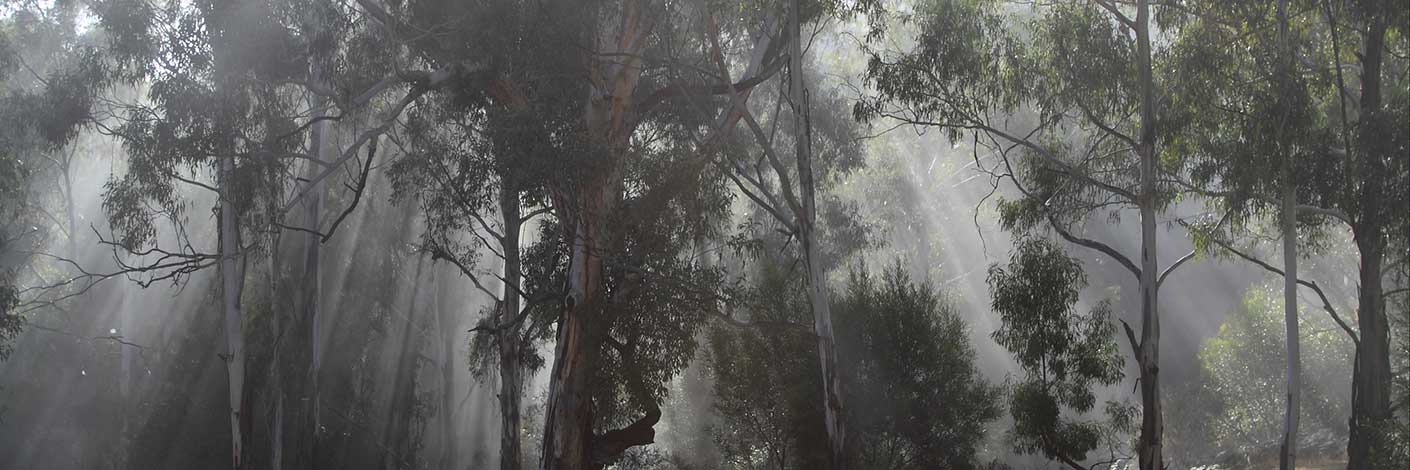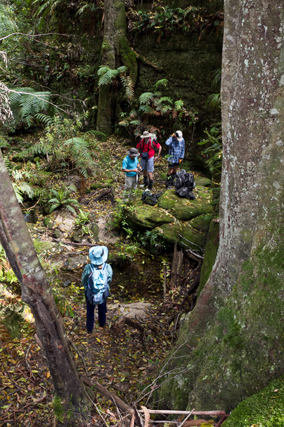Bush Explorers Encyclopaedia
Rats Castle
One of the construction camps on the Wolgan Valley Railway near the modern day Glowworm Tunnel was called Greens Camp. This camp housed up to 600 workers. It was large enough to have its own temporary post office. It was also a place prone to squalor and misery. Carved deep into a rock outside the camp on the current Pagoda Track, are the framed letters RATSCASTLE. On discovering this graffiti, Brian Fox undertook research. There is a strong emotive correlation between this location and the rebellious and infamous outlawed Kelly Gang. Keith Maxwell, another passionate researcher, wrote a sobering piece,“we cannot forget changes to the working week. Early in the 20th century you had the ‘eight hour day’ campaign – eight hours work, eight hours sleep and eight hours relaxation. The aim was a 48 hour week (6 days x 8 hours). Further campaigns were the 44 hours week, (4 hours only on Saturday) before the 40 hour week.” Hence our 600 men from the railway camp were almost certainly on a six day working week of days longer than eight hours. We suspect the signage was a form of protest against inhuman conditions.
Red Cliffs
Refers to the main cliff line on the northern side of Capertee Creek. The property below this cliff line in the1960s was owned by three brothers, Les, Neil and Geoff Taylor, their property was called Red Cliffs. Ref: Deborah Taylor.
Red Cliffs.
Brown, Jim. Bent Backs, 1989, pp. 145-146, records, " old maps that refer to the eastern cliffs which rim Capertee as Red Cliffs, as they frequently display a glowing reddish ochre appearance towards evening as the sun sets in the west." This is an unofficial name, for the Geographical Names Board has approved the name, Red Rocks.
Red Hill
Is a small hill on the Wolgan Road, 1.5km west of Cape Horn. The hill was named not because of the summit but due to the gradient on the northern side, as before the road was sealed the red clay base in the wet made many a vehicle to be bogged. Ref: Lithgow Mercury 24th February 1908, p. 1 records, “Passing Wolgan Station, the road for a short distance is quite red.”
Red Hill
Is on the Old Bells Line of Road, 1.5km north west of Bungleboori Camping Ground. Ref: Correspondence, Danny Whitty, local historian, 3rd July 2010. Local usage name, c1960s. Named due to the red soil.
Red Rock Creek *
Is a non perennial creek rising at Woolpack Rock. It flows generally north east and north for about 15km into Coco Creek. Red Rock Creek is shown on the map Parish of Wolgan, 1884.
Red Rock Flat *
Is a gently sloping area of land alongside and midway along Red Rock Creek, 5.7km west of Newnes. The name Red Rock Flat is recorded under County Land Sales, SMH, 11th May 1858, p. 3. Access via Red Rock Trail.
Red Rocks *
Is the name of the cliff face between Point Anderson and Point Nicholson. The name Red Rocks is shown on Survey Plan dated, 5th February 1856. Original name, The Red Rocks, is a descriptive name of the colour of the rock face in this area.
Red Rock Trail
Is a1.1km trail leading from The Meadows Trail towards Red Rock Creek. Carne, J E. Field Book, State Records, 2/653-654, 1900-1903, records, "Red Rock Track."
Red Springs Creek *
Is a watercourse rising about 1km east of Kirbys Hill and 3km north, north west of Cullen Bullen. It flows for about 3km generally south west into Dulhuntys Creek. Shown as, "The Red Spring" on the Survey Plan 255.1496, Parish of Cullen Bullen, dated, 30th November 1861.
Reedy Creek
Is a non perennial creek rising 2.5km south east of Mount Airly. It flows generally south for about 5km into Airly Creek. This is a descriptive name. Shown on the map Parish of Coco, 1883.
Reedy Creek *
Is a partly perennial creek rising near Mount Sinai 1km west of the Clarence Railway Station. It flows generally in a southerly direction for about 6.5km to its junction with the River Lett. So named, as near the junction with River Lett the ground is swampy. Ref: Parish of Lett, 2nd edition, 1890.
Richardsons Swamp
Was part of the upper reaches of Bungleboori Creek, south of Mount Horne. The current Lithgow Topo Map does not show any swamp in this area. GR 426 000. Most likely named after Harry Richardson (1848-1915), Outdoor Superintendent, NSW Government Railways, of the north and west railway lines. At his death, 23rd June 1915, he was Commissioner for Railways. SMH 25.06.1915, p. 5. Ref: Tramway from Wolgan to Clarence. Survey Plan M12435. Surveyed by John Haydon Cardew, 13th December 1905.
River Caves
Are located on Budgary Creek, 1.5km south east of Mount Budgary. Access is via Mount Cameron Trail to barrier and walking north west down to the creek. Also known as River Caves Canyon. The River Caves were noted by two brothers, Alan and Russell May, and John Norris in c1948; they called it, The Water Tunnel. They found it by walking down Budgary Creek. Ref: Correspondence with David Warren Noble, 14th October 2009. Oral history with Ken Poppett, 24 February 2012 records,"The May brothers referred to it as RiverTunnels, they did not like the feature referred to as the River Caves," which is the current usage.
River Lett *
Dargans Creek and Kangaroo Corner Creek join to form the creek known as River Lett. This is a partly perennial creek which flows west, south west for about 6km into the Coxs River. This name was originally recorded by George Evans as Rivulett and repeated twice on his map. Ref: Surveyor G. W. Evans. Plan of route over the Blue Mountains from Emu Ford to Fish River Crossing. In 3 sheets, Sheet 3, scale 40 chains to an inch, 1815. LDI. 215 (3). When Surveyor Henry Butler was requested to survey the proposed reserve for a Court House and Gaol, (Hartley Court House), 25th July 1834, he recorded on his Survey Plan the spelling as River Lett. Ref: Survey Plan B228.691. Note: the spelling on the Great Western Highway at Hartley is shown incorrectly as Lett River.
Rockflower Creek
This creek is 4.2km long, has its headwaters between the western extremity of Sunnyside Ridge Road and Cape Pinnacle. It flows north, north west for 1.6km before dropping over the cliff line and then flowing into the Wolgan River at the locality called Jacks Camp. Name coined by Brian Fox, 9th September 2011, in keeping with the name Rockflower Ridge.
Rockflower Creek Passage
Is a 200m fern decked passage that follows the upper section of Rockflower Creek from the Gardens of Stone National Park boundary to the cliff line overlooking the Wolgan Valley. So named by Yuri Bolotin, on a Bush Club walk, 5th September 2011. This passage goes through part of the western side of Rockflower Ridge studded with pagodas.
Rockflower Ridge
Extends off the western extremity of Sunnyside Ridge Road and trends north, north west and north towards Cape Pinnacle. Named by Yuri Bolotin on a Bush Club walk, 5th September 2011 and described by Yuri as,"we found all kinds of incredible rock formations coming into our view. Not many of them were more than a meter tall, but they were exquisite in form and reminded me of beautiful weirdly shaped flowers one may encounter while walking through an enchanted garden. It is for this reason that I named this place Rockflower Ridge."
Rock Hill *
Is located 5km north east of Deep Pass and 3.8km south of Mount Cameron. It is shown on the map Parish of Rock Hill, 1st edition, 1882. Elevation of 965m.
Rockinghorse Arch
Michael Keats records, " The arch shaped rock is an ironstone residual that has more perforations than actual support rock holding it together. There are three major support points and these are all fluted, decorated and fenestrated like no other rock I have seen before. The interior of the arch is large enough to crawl into, and through if you are so inclined." Located above the cliff line on the northern side of the headwaters of Capertee Creek, 1.4km north east of Mount Dawson. Named by Yuri Bolotin on a Bush Club walk, 28th October 2013.
Rock Island
An aerial photograph taken in c1948 showed the whole area appearing as single rock. The "island" is surrounded on the north, east and south sides by the tributaries of Deanes Creek. The "island" is located principally in the south west corner of the Mount Morgan Topographic Map. Using the 900m contour, the south west corner is at GR 436 178 and the north east corner at GR 443 189. The name was created by the original three who proposed the Gardens of Stone National Park, Rodney Falconer, David Blackwell and Dr Haydn Washington, November 1984. Ref: Correspondence with David Blackwell, 2nd May 2010, who records,"This name was given when spotted from the air making a flight / air survey of the areas rich with Pagodas. Rock Island was extremely distinctive with low heath type vegetation, which was laid out with the most distinctive top surface contours of the island just like a "contour" topographical model. Small trees have grown some but the surface has so little soil the island is still distinctive from the landscape around."In 2012, the area was covered with Allocasuarina nana and the name is not quite so apposite.
Rocky Creek *
Is a perennial creek rising north of Cockatoo Hill. It flows generally north east and north for about 20km into the Wolgan River, about 8.5km south east of Newnes. This is a descriptive name. Shown on the map Parish of Gindantherie, 1892.
Rodwells Bank Siding
On the Wolgan Valley Railway was the site of a mill for cutting railway sleepers, c1908. It was located about 150m from the GlowwormTunnel on the western (Newnes) side. Ref: Notes of Sid Rosewarne within Stephens, Eric. Wolgan Railway Notebook, 1934-1937. Thomas Rodwell was listed as a Newnes resident.
Roller Coaster Slot
This slot is located 400m a bit north of west from the barrier on the Old Coach Road and 450 m north of the Glowworm Tunnel.Named by Michael Keats on a Bush Club walk, 12th August 2011.
Romeo Grotto
Is about 15m in three dimensions of almost totally enclosed space and was highlighted by a natural rope of tree roots that had grown down from the centre of the creek above and become rooted in the pool below. Located at the southern end of Sunnyside Gully. Access via Sunnyside Ridge, Fire Trail No. 7. Named by Michael Keats on Bush Club walk 7th February 2014, Mike recorded, "I can see Romeo climbing that rope to Juliet's Balcony."
Ronald Cave
Was located within Pavilion Gully, Hassans Walls Reserve, Lithgow. Rock falls have destroyed this overhang. Named after Captain Ronald Burns, who lost his life at the landing on Gallipoli on April 25th 1915 – the first soldier from Lithgow to die at Gallipoli. Lithgow Mercury, 8th December 1916, p. 6.
Rowans Gap
Is a a saddle located south west of Rowans Hole and at the junction of Rowans Hole Trail and Moffitts Trail. Ben Bullen Topo Map, GR 253 192. Ref: Carne, Joseph. The Kerosene Shale Deposits of New South Wales, 1903, p. 176. Applied for by Walter Rowan. Portion 41, 23rd December 1875 as Conditional Purchase. Portion 37 and 40, 30th December 1875 as Conditional Purchase. Scale 20 Chains to an Inch. Date of Survey 26th January 1877.
The Index to the Unassisted Arrivals in NSW records, “Mr W Rowan arrived in Sydney as an unassisted passenger on the ship ‘Pluto’ from Melbourne on the 22nd February 1855.”NSW BDM records, “Walter Rowan married Sarah Murdock, district Hartley, 1863, two children, Sarah born 1864 and Thomas born 1866. Walter died 1882.” Ref: NSW BDM Rego No. 8800/1882.When Walter died, the leases were transferred to wife, Sarah. She died in 1879. Ref: NSW BDM, Conditional Purchases Register Book, State Records, Kingswood and Survey Plan R1460-1496.
Certificate of Title records, “Jonathan McLean purchased Portion 40 and 41. Portion 41 was purchased for £60.” His Title was Recorded and Enrolled in the Registrar General’s Office, Sydney, 23rd June 1904. Jonathan McLean’s grandparents, John and Marion McLean, were among the earliest settlers in the Glen Alice, Capertee Valley in 1837. Mount McLean and McLeans Pass are named after this family.
Portion 41 passed onto Kate Augusta McLean on the death of her husband Jonathan McLean on 23rd November 1907. On Kate’s death, the land was passed onto her son William John McLean, a Sydney solicitor on the 18th March 1932. On the same day, William sold to Thomas William Wolfe Gardiner, a grazier of Ben Bullen. The geographical features, Gardiners Hill and Gardiners Gap, were named after Thomas Gardiner’s father Thomas, and grandfather William.
The next owner was Ronald Horace Lillyman, a grazier from Molong, 9th October 1956, then the property was sold to Virginia Gai McCann of Ben Bullen on 16th January 1961. Ref: Volume 1540; Folio 70. Virginia Gai McCann passed the land onto Matthew Anthony McCann on 30th July 1973. It was then sold to Merevn Jack Crane on 23rd September 1977. Ref: Vol. 8268; Fol. 159. The next five owners held the land for a short amount of time each, before the land was sold to the current owners, John Christian Murray and Katherine Lynne McFarlane on the 29th May 2007.
Note: from the original Survey Plan, this Portion has never been further subdivided and is described as Lot 41, Deposited Plan 755759.
Rowans Hole *
Is a basin like valley at the headwaters of Coco Creek within the Capertee Valley. Road access is via Castlereagh Highway at Ben Bullen, Hutchinson Road and Moffitts Trail. Ben Bullen Topo Map, GR 257 202.
Rowans Hole was part of the shortest stock route into and out of Capertee Valley. Annabella Boswell's Journal, p. 24, records in 1839,"One of these roads was known as, ‘The Hole’....was the best as well as the shortest way, but only available for persons walking or on horseback for there was one tremendous hill up and down.”
Before the lease of this land to Walter Rowan, the area was known as Dulhuntys Hole. Ref: Parish of Ben Bullen, 1885. Subsequent parish maps recorded the name as Rowans Hole. Robert Venour Dulhunty had selected 2000ac in 1824 and his property was called Cullen Bullen.
The Survey Plan 1460-1496 has “Note: In the advent of the Conditional Purchase becoming Lapsed or Forfeited the plan should be forwarded to the Reserve Branch with a view of including the area in Railway Reserve 180; Notified 5th December 1883.”Portions 40, 60 acres and 41, 40 acres, show the name Coco or Cooks Creek and swamp through the western side of these Portions.
Note: as the survey was completed two years after the Conditional Purchase, the plan shows the outline of Corn Paddock on Portion 41, a hut in the centre and garden on the north side of the hut. The plan records, “Value of Improvements, Hut £26, Fencing £30, Clearing £20, Ringbarking £2, Total £78.” Ref: Survey Plan 1460-1496.
Carne, Joseph. Geology and Mineral Resources of the Western Coalfield, 1908, p. 68 describes Holes as“streams heading in volcanic necks have sawn through encircling precipitous cliffs, producing a resemblance to frying pans with long crooked handles; such are discriminated as ‘round topped arms’, arm being synonymous with creek or stream. Holes are also suggestive appellations for the circular heads of those channels.”
Roxburgh, County *
Is the administrative area of the County of Roxburgh. It adjoins the northern side of the County of Cook, with Glen Alice being on its southern end. When Dr James Innes (1796-1846) was granted 1760ac in October 1831, the location was recorded as Parish unnamed at Capertee. James ancestor, was James Innes-Ker 3rd Duke of Roxburgh (1736-1823). Ref: web site,www.absoluteastronomy.com
Ruined Castles
Are a group of pagodas above the western side of Neubecks Creek, 1km south east of Invincible Trig.“I am running day trips to another area….. I call it the Ruined Castles”. Vic Widman, Great Divide Tours. Named 2014. Vic had in the 1989 named Lost City (Lithgow Topo Map, 371 988) and this name is in keeping with the similar theme.
Russell Creek *
Is a watercourse rising 1.5km north east of Capertee. It flows generally south east and north east for about 2.5km into Airly Creek. Shown as Russells Waterhole Creek on the map Parish of Bandamora, 1882. Captain William Russell (1807-1866) married Jane Rebecca Griffiths Jamison in 1841. Jane was the daughter of Sir John Jamison. They had 3 daughters and 8 sons. Along with his father in law and Dulhuntys, he was one of the first landowners in the Cullen Bullen, Ben Bullen area. His first purchase of 11 Portions of Land was on 4th September 1852. Russell was also a Member of the Legislative Assembly, June 1859 - November 1860. Ref: Survey Plans 57 and 58-1496, 891-1496. NSW Parliament Former Members website.
Rutherford Glen
Is located 600m north west of Padleys Pedestal Trig Station, within Hassans Walls Reserve, Lithgow. Named after James Rutherford (1827-1911). In 1873, with Daniel Williams and others he started the Eskbank Ironworks at Lithgow. Ref: Lithgow Mercury, 18th May 1917, p. 6. This glen has a walking track which connects to the Undercliff Track. The first overhang from the top is known as Hurley Cave.
Ryans Cave and Lookout
Is located within Hassans Glen, it is the last rock overhang on the upper track on the western side of Hassans Glen about 40 metres past Hoskins Cave within Hassans Walls Reserve, Lithgow. Named after James Ryan (1863-1940), who was a former editor of the Lithgow Mercury, Member of the Legislative Council and Hassans Walls Trustee. Ref: Lithgow Mercury, 14th May 1915, p. 4. Former Members of Parliament website.
Saddle Lookout
Sahara Point
Is the westernmost end of Sunnyside Ridge Road. Named by rock climbers who have been climbing from this point since 1975. So named as there is not a drop of water in this area. Overlooks the upper escarpment of the Wolgan Valley. Name recorded in Taylor, Pete and Penney, Andrew. The Wolgan Guide, 1984, p. 116.
Sanctuary Cave
So named by John Fox on a Bush Club walk, 16th June 2014. This cave with faint Aboriginal drawings and European usage would have provided an ideal sanctuary for them. Located on the southern side of Beecroft Firetrail. 820m southeast of Beecroft Trig.
Sand Cave
Is located just above the main cliff line about 800m due west of the junction of Fire Trail No. 7 and Glowworm Tunnel Road. It has a more or less level floor and in times of heavy rain water washes sand through the cave. This cave is 40m long, 10m high and 18m deep.
Sandford Cave
Is the first overhang when descending into Hassans Glen at Hassans Walls Reserve, Lithgow. Named after William Sandford by the Lithgow Progress Association Lithgow Mercury, 14th May 1915, p. 4. Hartley Topo Map, GR 355 883. Sandford took over the iron works at Lithgow in 1886 and was a pioneer in the Australia’s steel making industry. The ledge from Sandford Cave leads to Pillans Lookout and above the rock formation was the original 1915 Bracys Lookout and the feature known as Natural Throne.
Sandy Gully
Is a 3km non perennial creek rising on Glen Davis Road. It is the next gully south west of Nuggety Gully. It flows south east into Coco Creek. Named by Alexander McLean, a local resident who found gold in this gully, the largest nugget being 30 ounces. Ref: Carne, Joseph. The Kerosene Shale Deposits of New South Wales, 1903, p. 132. Name not shown on any Topo Map.
Sapling Flat *
Is a locality about 1.5km north west of Mount Harvey and about 3.5km north east of Mount Stewart. Sapling Flat is recorded under County Land Sales, SMH, 11th May 1858, p. 3. The word sapling refers to a young tree.
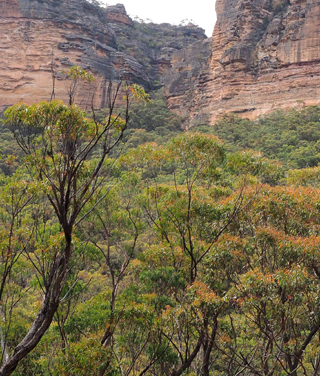
Sapling Flat Creek *
Is a non perennial creek rising at Hughes Defile. It flows generally north, north east and north, north west for about 7km into Crown Creek at Crown Swamp. Sapling Flat Creek was recorded as Sapling Flat Gully in the NSW Government Gazette, 26th February 1875.
Sawyers Swamp *
Lies at the headwaters of an ash settlement dam at Kerosene Vale, 3.5km west of Lidsdale. The Sydney Morning Herald, 22 August 1854, p. 5, records, "County Lots for sale, 34 acres at Sawyers Swamp, at the upset price of one pound per acre."Survey Plan C121-1507, dated 13th October 1856, records the name Sawyers Swamp.
Scatters Ridge
Is a spur, 1.4km in length, off the southern side of Waratah Ridge. Named by Peter Fox, National Parks Association bushwalker, between the years 1995-1998. Peter had it named it after Scatters Canyon, which is a side canyon off the northern side of Bungleboori Creek. Wollangambe Topo Map, creek junction GR 506 006. Scatters Canyon is recorded in Jamieson, Rick. Canyons Near Sydney, 4th edition, 2001.
Scimitar Slot Canyon
Is a 150m slot canyon located 3.9km north east of the junction of Glowworm Tunnel Road and Old Coach Road and close to and above the junction of Henry Creek and Deanes Creek. So named by Michael Keats on a Bush Club walk, 10th August 2012. Michael recorded,"This name reflects the shape, the curvature and the precise deep cut that this landform makes in the terrain at the end of the Henry Creek, Deanes Creek peninsula."
Screwdriver Pass
Is a natural pass giving access from the plateau off Glowworm Tunnel Road towards Carne Creek, 2km east, north east of Wolgan Pinnacle. This descriptive name was coined by Michael Keats on his Bush Club walk, 10th October 2007.
Seal Rock
So named as this rock formation is poised like a seal seating on top of a rock waiting to be fed fish after a performance. Located 1.3km north east of Invincible Trig Station. Named by Daryl Watson, a bushwalker, on a Bush Club walk, 15th August 2013.
Second Lookout
Is located off a side track from Hassans Walls Road, Lithgow. Midway between Padleys Pedestal Trig and Browns Gap. A shelter shed constructed in 1939 and Hartley Trig are also located in this vicinity. So named as this area was the second reserve added to Hassans Walls Reserve in 1938. The far southern point of land is known as Finnigans Point.
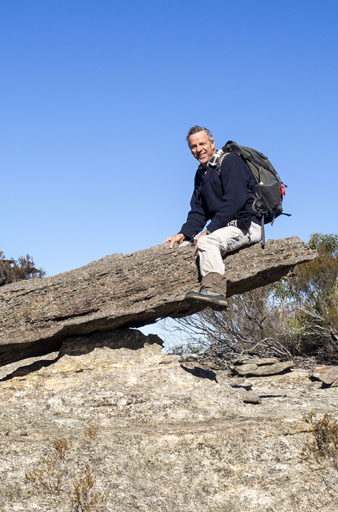
See-Saw Point
Is located 500m east of Genowlan Trig above the Glen Davis Road. A natural rock formation likened to a see saw was acted out by Brian Fox and Yuri Bolotin on Bush Club walk, 1st June 2015. Another walk on the 26th June 2015 noted the extensive views from this location and hence the name coined by Yuri Bolotin. Genowlan Trig which is at a higher elevation has no views owing to the regrowth of vegetation.
Semicircular Wall
Sentinel Pass
Sentinel Pass gives access from Glowworm Tunnel Road towards Koan Cave, the Flying Carpet and Carne Creek. Named on a bushwalk by Brian Fox and Yuri Bolotin, 12 July 2019. So named due to the distinguishing 15m high sentinel rock pagoda near the top of the pass.
Sentinel Rock or Dooleys Lookout
Is above the upper track and in the centre of Hassans Glen within Hassans Walls Reserve, Lithgow. Lithgow Mercury, 14th May 1915, p. 4. Named after James Thomas Dooley (1877-1950) Member of the Legislative Assembly and former Premier of NSW. Ref: Former Members of Parliament website.
Sheedys Gully *
Has its headwaters on the southern side of Hassans Walls, Lithgow and the western and southern side is ringed by Hassans Walls Road. This four pronged gully flows generally northwards towards Farmers Creek. Named after the Sheedy family, who owned a 132 acre farm in this area in the 1860s. Thomas (1815-1890) and Johanna (1812-1882) had eight children. Ref: The Sydney Morning Herald, 30th March 1870, p. 8 and Lithgow Mercury 14th July 1920, p. 2. Bowenfels Cemetery inscription. The name Sheedys Gully was recorded in the Australian Star 30th October 1889, p. 5.
Shepherds Gully
Is officially known as (see entry) Capertee Creek. Ref: Interview with Dick Bird and Ron Bourke, 29th January 2010. Local usage name. Named after the property owners, Shepherd. Described as, a beautiful enclosed valley.
Shovel Cave
Is located just above the main cliff line about 800m due west of the junction of Fire Trail No. 7 and Glowworm Tunnel Road. So named because of an old, round nose shovel leaning up against its back wall. This cave is 30m long, 15m high and 7m deep. Close by is an overhang known as the Sand Cave.
Shunt Pass
Forms a natural staircase leading in from the vicinity of The Governor, all the way to the top cliff line, 750m west of the road intersection of Glowworm Tunnel Road and Fire Trail No. 7. Named by Michael Keats on a Bush Club walk, 21st September 2007. This name relates to the steam railway days, when the Glowworm Tunnel Road was the track of the steam driven trains on the Wolgan Valley Railway line to Newnes.
Shunt Track
Is the unformed walking track which follows the base of the cliff line below The Governor.
Signature Cave
Is located 1km north east of Invincible Trig Station at the easternmost end of a small valley. Measuring about 50m across, 18m wide from the back wall to the drip line, and 25m high, it has presence from sheer size alone. It also is the location of a lot of fading graffiti. It includes an internal natural spring, many glass shards dating from the 1930s and a cut log for a seat. Named by Brian Fox and Michael Keats on a Bush Club walk,15th August 2013.
Silkpod Creek
Has its headwaters on the eastern side of the intersection of Sunnyside Ridge Road and Fire Trail No. 4. This creek flows in a generally eastern direction for 2.7km to its junction with Carne Creek.
Silkpod Gorge
Silkpod Creek has its headwaters on the eastern side of the intersection of Sunnyside Ridge Road and Fire Trail No. 4. This creek flows in a generally eastern direction for 2.7km to its junction with Carne Creek at GR 410 071. Within Silkpod Creek is Silkpod Gorge, and Silkpod Slot, GR 411 072. All so named by Yuri Bolotin and Michael Keats on a Bush Club walk, 6th September 2013 due to the profusion of the rare Mountain Silkpod,Parsonsia brownii.
Silkpod Point
Is the northern point of a small spur that is above the junction of Silkpod and Carne Creeks. Within Silkpod Creek is Silkpod Gorge, GR 409 074, and Silkpod Slot, GR 411 072. All so named by Yuri Bolotin and Michael Keats on a Bush Club walk, 6th September 2013 due to the profusion of the rare Mountain Silkpod, Parsonsia brownii.
Silkpod Slot
Silkpod Creek has its headwaters on the eastern side of the intersection of Sunnyside Ridge Road and Fire Trail No. 4. This creek flows in a generally eastern direction for 2.7km to its junction with Carne Creek. Within Silkpod Creek is Silkpod Gorge, GR 409 074, and Silkpod Slot. All so named by Yuri Bolotin and Michael Keats on a Bush Club walk, 6th September 2013 due to the profusion of the rare Mountain Silkpod,Parsonsia brownii.
Silver Slot
Is located within the Eldorado Slots above Eldorado Walls, 1.5km due south of the old Newnes Hotel. This slot is about 160 metres in length and has a variable width from one to six metres. Jointly named by Yuri Bolotin, Michael Keats and Brian Fox on a Bush Club walk, 10th October 2016 in keeping with the Eldorado theme.
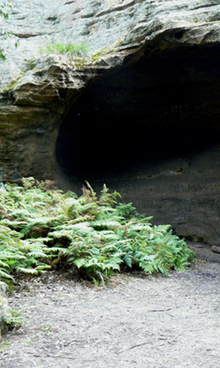
Singing Cave
Access is via Wolgan Road and off Blackfellows Hand Trail. Situated about 800m east, south east of Wolgan Gap. Named by the Woody Pear Walking Group in 1990. They visited this area a number of times and sang in this overhang. This group started due to an Outdoors TAFE course led by Margaret Baker. Ref: Olive Noble's track notes from Woody Pear Walking Group, 22nd July and 3rd November 1990.
Sinnamon Creek
Is now known as (see entry) Penrose Gully. This name was recordedon the original linen tracing for the Wolgan Valley Railway. Ref: Stephen, Eric. Wolgan Valley Railway Notebook. The railway line crossed this creek at 426 208.
Sinusoidal Ravine
Is within the lower section of Birds Rock Creek. As the name suggests, the last 1km of this creek system before it reaches Carne Creek sharply winds back and forth within a cliff lined ravine. Named by Michael Keats on a Bush Club walk, 11th July 2011.
Sir Johns Mouth *
Refers to the area where the wide portion of Capertee Valley and River narrows between two headlands. Descriptive of the valley and river narrowing into a mouth. Sir Johns Point and Mount Gundangaroo form the southern side and Mount Iris is on the northern side. It is also the area where the present Glen Alice Road from the north and Glen Davis Road from the west intersect. Named after Sir John Jamison (1776-1844), physician, landowner and constitutional reformer. Shown on Map of the Colony of New South Wales by Thomas Mitchell, 1834. "Sir Johns Mouth, the river has eroded its channel though both the Hawkesbury Series and the Coal measures, and for some depth into the Upper Marine strata, leaving on either hand bold headlands capped with sandstone cliffs." Ref: Carne, Joseph. The Kerosene Shale Deposits of New South Wales, 1903, p. 166.
Sir Johns Point *
Is a bluff on the southern side of Capertee River. It is the northern extremity of Mount Gundangaroo. See Mount Jamison for more details re John Jamison. Named after Sir John Jamison, who held extensive land holdings in Capertee Valley. RAHS Journal Vol. 45; Pt. 2; p. 92.
Sir Joseph Cook Boardwalk
Was named and constructed in 2013 by Lithgow City Council on the centenary of Sir Joseph Cook’s appointment as prime Minister of Australia. Located at Hassan Walls Reserve, it extends from near the shelter shed for 80 metres towards Padleys Pedestal Trig. Magnificent views over Hartley Valley.
Sisyphean Ridge
Roughly parallels the Moffitts Trail on the west and Zeus Ridge on the east, and both sides contain tributaries of Jews Creek. It is just one kilometre in length, trending north east. The name reflects the Greek mythological references of the ridges to the east, Zeus, Poseidon and Hades. Sisyphus was a Greek Titan who was condemned eternally to roll a huge stone up a hill that rolled back as soon as it reached the top. The name was applied to this ridge after observing a massive chock stone that stands poised to crash into the valley below, Sisyphus Rock is the highest point at GR 276 187. So named on a Bush Club walk, 25th July 2011 by Adrian Cooper, a bush walker and canyoner.
Size 8 Canyon
This canyon is 200m in length, and shaped as the letter "C". Located 1.1km east of Wolgan River and the junction with Tunnel Creek. Named by Michael Keats on a Bush Club walk, 8th April 2009. The tight access to this canyon would require any explorers, male or female, to be that dress size or less.
Skittle Row
Is a line of pagodas set up as a "row of skittles" in the Ben Bullen State Forest,midway between the headwaters of the Coxs River and Ben Bullen Creek. The Cullen Bullen Topo Map shows four of them, GR 286 130, GR 286 132, GR 286 133 and GR 286 134. The northernmost is at GR 286 138. This is a descriptive name proposed by Michael Keats on a bush walk into the area, 22nd August 2008. If careless underground mining continues, it is likely to send the skittles tumbling.
Skywalker Defile
Is 180m long and drops 90m through the cliffs between the top of Old Baldy and the lower plateau. As it leads to within 100m of the western end of Skywalker Traverse, Yuri Bolotin and Brian Fox on a bushwalk 14 July 2017 called it, Skywalker Defile.
Skywalker Traverse
So named by Yuri Bolotin on a bushwalk, 2nd October 2015. Yuri successfully led and found a traverse along the tree covered ledge midway up the cliff face known as Old Baldy, which overlooks the Newnes historic hotel and camping ground directly below.
Slice of Heaven
Refers to a pagoda studded area which lies between two magnificent, 50 to 100m wide, parallel slots. It is within the general region of Holts Heaven, hence the name, which was coined by Michael Keats on a Bush Club walk, 7th January 2012. Access via Girdwood Ridge, eastern side of Bald Trig Station.
Snake Gully
See Permafrost Gully. This is a descriptive name. Ref: Christison, Ray. Lithgow State Mine - A Pictorial History, 2009.
Snake Hill
Is located on Coopers Ridge, at an elevation of 1015m, 2.5km north east of Bald Trig Station. Peter Fox, a member of the National Parks Association, named this hill in the late 1990s, after a confrontation with a snake. In subsequent walks, snakes were also seen in this vicinity.
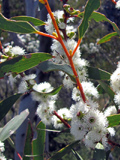
Snow Gum Flora Reserve *
Is located 2.5km south west of Bungleboori Camping Ground and in the vicinity of the Lost City. It lies within Newnes State Forest. Named afterEucalyptus gregsoniana, commonly known as Wolgan or Mallee Snow Gum, that are growing in this area. This is part of the Bathurst Forest Management Area. It covers 102ha. The area was suggested for preservation in December 1984 and the proposal was accepted in February 1985. Ref: Working Plan, Snow Gum Flora Reserve No. 166, Part of Newnes State Forest No. 748. Gazettal Notice, 22nd July 1994.
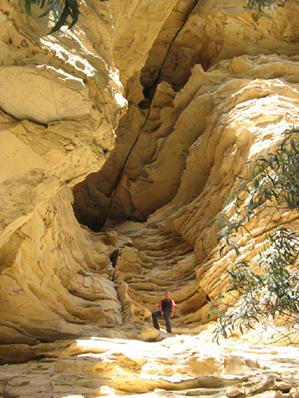
Solo Gully
Is the east west descending gully for rock climbers off Old Baldy, Newnes. This gully is 800m in length and joins Petries Gully. Name recorded in Stephens, Wade. Wolgan Valley Selected Climbing Areas, 2001.
Spanish Steps
Refers to the succession of sandstone benches on Fire Trail No. 5, which joins the Blackfellows Hand Trail to Sunnyside Ridge Road. The Wolgan River is crossed at the lowest point on the trail. The Spanish Steps are located on the northern side about 100m after crossing the Wolgan River. Named after the Spanish Steps of Piazza di Spagna in Rome, Italy. It is a descriptive name of the sandstone rock layered step formation. State Forests with the assistance of 4WD clubs closed vehicle access to the Spanish Steps in June 2003, but the barrier has since been vandalised.
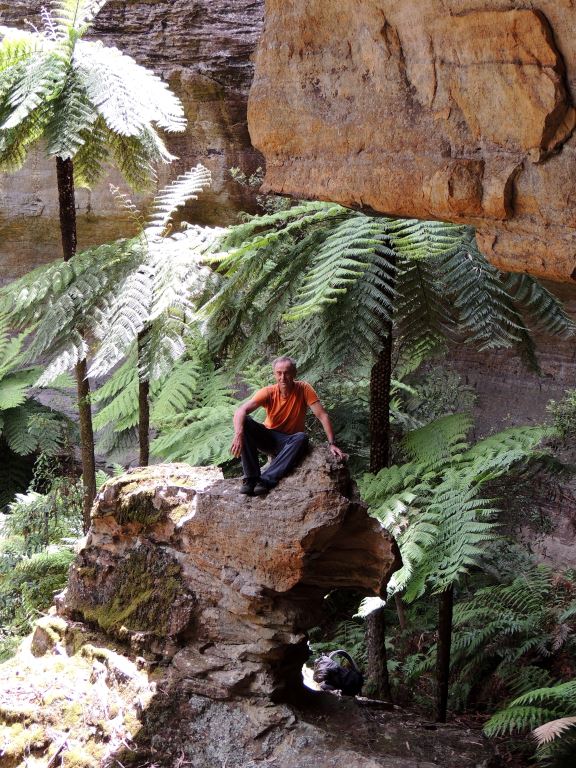
Sphinx Chamber
Is located within the Coach Galleries, 1.1km north east of Glowworm Tunnel. This chamber comprises a large overhang featuring a 2.5m high internal sculpture resembling an Egyptian Sphinx. A group cluster of giant bright green Tree Ferns behind it provides a brilliant background for photographs. Named by Yuri Bolotin and Brian Fox on a bush walk 23 December 2016.
Spiracle Pass
Is a bush walking pass 1.7km east, north east of Mount Budgary, that leads into Budgary Creek. Named by Michael Keats, 5th August 2009. This pass and Lanceolate, Ocellus, Pheromone and Frenulum Passes, all near Mount Budgary, are named after an anatomical part of a Moth. Michael had encountered a large numbers of Moths during his walks on Mount Budgary Plateau.
Split Rock Pass
Split Rock Point
Springvale Creek
Is a multi stemmed dendritic drainage system spread over 2km, rising on the western side of Marrangaroo Ridge. It flows generally in a north west direction for 4.5km till it joins the Coxs River near Wallerawang Power Station. The name is derived from the locality, Springvale, in which the creek flows.
Stage Cave
Is located near the northern end of a ravine, 900m south of Kangaroos Creek Road and Beecroft Firetrail, between Clerestory Spurs 4 and 5. This cave has a clean level floor and a perfectly semicircular stage backdrop filled with ferns. Named by Michael Keats on a Bush Club walk, 6th October 2010.
Stairway to Heaven
Was named by Yuri Bolotin on Bush Club walk, 7th September 2015. So named as the walk / climb up the eastern side of Point Hatteras at Airly was a very hairy experience and felt like heaven to be on top.
Stargate Point
Is an exposed point of pagoda crested rock located on top of the eastern cliff line 350m south of Mount Jamison and 1.8km east of Baal Bone Gap. Views down and across the Wolgan Valley. So named by Brian Fox and Michael Keats on a Bush Club walk, 1st February 2016 as Stargate Tunnel is 600m south, south west of this point.
Stargate Slots
Is a series of slots near the cliff line on the south western side of Mount Jamison. One of the slots gives an easy access from Stargate Trail to the top of Mount Jamison. The main slot, some 40 m in length, has 10 m high, almost parallel walls and averages 50 cm in width. Subsidiary slots, generally disposed at right angles to it, are much shorter and have less spectacular geometry. So named by Michael Keats and Brian Fox on a bushwalk walk, 1st February 2016.
Stargate Trail
Is an undefined mid-cliffl edge track that starts at Stargate Tunnel eastern side and follows a serpentine and variable width ledge for about 700 m, where a natural pass, Stargate Slots, provides access to the southwestern side of Mount Jamison. So named by Harold Thompson on a bushwalk, 1st February 2016.
Stargate Tunnel
Is a short water worn canyon formed by the tilting of a large sandstone block creating a triangular tunnel over a shallow, sandy creek bed. The tunnel section is 21m long and it averages 7m in width. The height varies and is up to 10m. Located 100m south of McLeans Pass. Access from Lidsdale via Wolgan Road, The Bicentennial National Trail and ridge line (Great Dividing Range). A log book in an old biscuit tin records that this cave is regularly visited. The very first entry, dated Sunday 17th August 1975, reads, "Gary named this Stargate Tunnel. We stayed overnight and watched sunset from the cliffs overlooking Capertee Valley. And then we got up at 6:30 to watch the sunrise. Very cold but we consider it was worthwhile. John and Martin came too and we sprang around like callow youths.Terry Moesker." The four bush walkers were Gary Hansen (1943-1982), John Cameron, Terry and Martin Moesker.
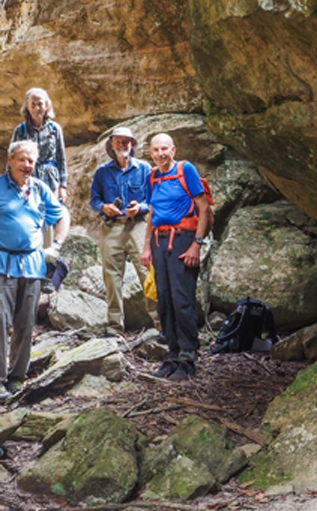
Stargate Tunnels South
are located below the first cliff line between Cape Horn and Stargate Tunnel. A number of small overhangs and tunnel systems some 30 m in length are so named by Michael Keats on a Bush Club walk, 29th February 2016.
Starlight Canyon
Is also known Newnes Canyon and Wallaby Canyon. Access for the purists is via the Pipeline Track at the top of the main watershed, then by following a ridge to enter the tributary creek system. The canyon can also be explored by walking upstream from the junction with the Wolgan River at GR 474 269. It is possible to walk in the canyon as far as the internal waterfall. A torch is essential.
State Mine Creek *
Flows most of its distance along the eastern side of State Mine Gully Road before coming under a bridge near the State Mine Railway Museum and hence into Farmers Creek.
